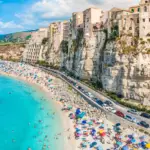
Welcome to Pamukkale, one Turkish scenario dazzling that attracts visitors from all over the world for their thermal waters and rock formations unique that resemble cotton. The name Pamukkale means “cotton castle” in Turkish, and it’s easy to see why when you see the crystal-clear white pools in terraced formations that resemble a castle.
Located in southwestern Turkey, Pamukkale is one of the most impressive natural wonders in the world, offering a unique and unforgettable experience for all ages.
Main points of this article:
- Discover the meaning of Pamukkale and its geographical features
- Explore the history of Pamukkale and its Roman remains
- Enjoy the medicinal properties of thermal waters from Pamukkale
- Marvel at the rock formations of Pamukkale, known as travertines
- Find helpful tips and curiosities interesting things about Pamukkale
What is Pamukkale?
Pamukkale is a tourist city located in the western region of Türkiye, known for its thermal waters and rock formations unique. The name Pamukkale means “cotton castle” in Turkish, referring to the white appearance of the formations, which resemble cotton.
The city is located in the Denizli province of Türkiye and is a tourist destination popular due to its impressive natural attractions. Pamukkale's hot springs are known for their therapeutic and medicinal properties, attracting visitors from all over the world.
The History of Pamukkale
In the heart of Türkiye, we find Pamukkale, a region famous for its thermal waters and unique rock formations that attract visitors from all over the world. But Pamukkale is not just a tourist destination; it is also a region rich in history and culture.
THE history of Pamukkale dates back to the ancient city of Hierapolis, which was famous for its hot springs and medicinal properties. During the Roman Empire, the city became an important center of commerce and religion, with several temples and sanctuaries built in the region.
Over time, Hierapolis passed through the hands of various rulers and empires, including the Byzantines and Seljuk Turks. In 1988, Pamukkale was declared a UNESCO World Heritage Site, recognizing its historical and cultural importance.
Today, visitors to Pamukkale can explore the ruins of Hierapolis and discover the rich layers of history that shaped this fascinating region.

The hot springs of Pamukkale
One of the main attractions of Pamukkale is its thermal waters, which flow from underground and form natural pools with medicinal propertiesWith temperatures ranging from 35°C to 100°C, the waters are rich in minerals and have several healing properties, which can help in the recovery of skin problems, arthritis, rheumatism, and several other health conditions.
The natural pools formed by the thermal waters are an invitation to relaxation and leisure. Visitors can soak in the warm waters and enjoy their therapeutic benefits. Furthermore, the pools are surrounded by a landscape of incomparable beauty, making the experience even more enjoyable.
It is worth remembering that it is important to take some precautions when enjoying the thermal waters of Pamukkale. Because the water is rich in minerals, it can damage clothing and accessories, so it's recommended to avoid wearing metal objects and jewelry in the pools. It's also important to maintain personal hygiene and avoid drinking the water.

The rock formations of Pamukkale
One of the main attractions of Pamukkale is its impressive rock formations, known as travertines. They are made of calcium carbonate and resemble giant cotton carpets, creating a unique and stunning scene.
These formations are the result of thousands of years of mineral precipitation from the region's hot springs, which accumulated and molded the rocks into different shapes and sizes. There are several natural pools, waterfalls, and terraces across several levels, creating a true paradise for the eyes.
Pamukkale's rock formations are whitish, brilliant, and delicate to the touch, a true work of art. Furthermore, the region is surrounded by mountains and has a mild climate most of the year, making the visit even more enjoyable.
The rock formations of Pamukkale are incredible and deserve to be seen up close to fully appreciate them. You can also walk barefoot on the rocks and feel the texture and temperature of the thermal waters, providing a unique and unforgettable experience.

What to do in Pamukkale
If you're planning a visit to Pamukkale, get ready for a world of exciting activities and sights.
One of the main tourist attractions in the area is the ancient city of Hierapolis, which boasts incredible Roman and Greek ruins. Visiting the Greco-Roman Theater and the Temple of Apollo is a unique experience that transports visitors to the past.
The natural pools formed by the thermal waters are another must-see attraction. After exploring the ruins, a dip in the turquoise waters is a relaxing way to end the day.
The unique rock formations of Pamukkale, known as travertines, are also a must-see attraction. Take the opportunity to walk among the formations and feel the cotton-like texture underfoot.
Pamukkale also offers visitors the opportunity to hike, bike, and take guided tours of the region. A visit to the Denizli Archaeological Museum is also highly recommended, where you can learn more about Turkey's history and culture.
With so many activities and sights to choose from, Pamukkale is a tourist destination sure to please even the most discerning traveler.
Tourism in Pamukkale
Pamukkale is one of Turkey's most popular tourist destinations, receiving thousands of visitors every year. With its thermal waters and unique rock formations, the site offers an experience unforgettable tourist experience for people of all ages and nationalities.
According to statistics, Pamukkale receives an average of one million visitors per year, coming from all over the world. Most tourists visit during the summer, when temperatures are higher and the weather conditions are more favorable.
| Tourist attractions in Pamukkale | Description |
|---|---|
| Thermal waters | The natural pools formed by Pamukkale's thermal waters are one of the region's main tourist attractions. Visitors can swim and relax in the therapeutic waters, which are known for their medicinal properties. |
| Rock formations | Pamukkale's rock formations, known as travertines, are another highlight of the region. With their white appearance and cotton-like appearance, the formations create a stunning landscape that captivates visitors. |
| Ruins of Hierapolis | The ancient city of Hierapolis, built on the site of Pamukkale over 2,000 years ago, is a popular tourist destination for history buffs. The city's ruins, which include an ancient theater and a cemetery, are a fascinating reminder of the region's rich cultural heritage. |
In addition to these main attractions, Pamukkale also offers a variety of tourist activities for visitors, including hiking, hot air balloon rides, tourism gastronomic and much more.
To ensure visitors have the best possible experience in Pamukkale, the region has a well-developed tourist infrastructure, which includes hotels, restaurants, public transport and tour guides.
THE tourism in Pamukkale has a significant impact on the local economy, contributing to job creation, increased tax revenue, and the development of new businesses. At the same time, it's important that visitors respect and preserve the natural beauty and cultural aspects of the region, avoiding behaviors that are harmful to the environment and local communities.
Tips for visiting Pamukkale
If you are planning a trip to visit Pamukkale, here are some helpful tips to make your experience even better:
What to bring
Since most of the visit will be outdoors, it's important to bring light, comfortable clothing, sunscreen, a hat, and sunglasses. It's also recommended to bring a towel and a change of clothes to make the most of the natural pools. Don't forget to bring a bottle of water to stay hydrated throughout your visit.
How to get there
The best way to get to Pamukkale is by flight to Denizli. Regular buses depart from the airport to Pamukkale frequently. If you're staying in Istanbul, you can also take a bus to Pamukkale, which usually takes about 12 hours.
Best time to visit
The best time to visit Pamukkale It's during spring, between March and May, or in autumn, between September and November, when temperatures are milder. During the summer, temperatures can be very high, making the visit more tiring.
How long to stay
To fully experience all that Pamukkale has to offer, it's recommended to stay at least two days. This will allow you to take a guided tour of the natural pools, explore the ruins of Hierapolis, and still enjoy some free time to relax and enjoy the view. natural beauty of the place.
Other practical information
It is not permitted to enter the natural pools wearing shoes or sandals. You must remove your shoes before entering the water. Furthermore, it is important to respect the rules of preservation of the place and do not take plastic bags, bottles or other materials that could damage the environment.
Fun Facts about Pamukkale
In addition to its hot springs and stunning rock formations, Pamukkale is home to many curiosities and interesting facts that few people know about. Here, we will explore some surprising information about this Turkish scenario incredible.
1. The origin of the name
The name Pamukkale comes from Turkish, meaning "cotton castle." The rock formations' striking resemblance to cotton is captivating and leaves visitors spellbound.
2. Historical importance
Pamukkale was once an important center of Roman civilization, and its neighboring city, Hierapolis, was one of the most important sacred cities of the time. the place houses many historical and cultural remains, such as the famous Necropolis, which is an important archaeological site.
3. Medicinal properties
Pamukkale's thermal waters have medicinal properties that help treat various ailments, such as skin diseases, respiratory and rheumatic problems, among others.
4. UNESCO World Heritage Site
Since 1988, Pamukkale has been recognized as a UNESCO World Heritage Site, meaning it is a natural treasure that needs to be protected and preserved. Therefore, it is important that all visitors respect the rules and care necessary for its maintenance.
5. The Legend of Cleopatra
According to legend, Cleopatra had a marble pool built in Hierapolis, where she bathed in the thermal waters to maintain her beauty and youth. The pool can still be seen by visitors, and its waters are believed to have rejuvenating qualities.
The preservation of Pamukkale.
Pamukkale is a unique natural treasure, and for this reason, it is essential that measures be taken to preserve its ecological beauty. environmental protection is an increasingly important topic around the world and Pamukkale is not far behind when it comes to this topic.
The Pamukkale region is designated a UNESCO World Heritage Site, meaning it is recognized as a valuable heritage site with unique characteristics that need to be preserved. UNESCO has worked hard to ensure the conservation of this site, promoting environmental education and awareness-raising initiatives for visitors and local residents.
Turkish authorities have also taken steps to preserve Pamukkale. Among the measures adopted are restrictions on the number of visitors, a ban on construction that could affect the environment, and the implementation of recycling and waste treatment programs.
It's important that all visitors to Pamukkale also take precautions to preserve the site. A few simple steps can help protect the environment and ensure the region remains a Turkish scenario charming and preserved for future generations. Among them, the following stand out:
- Do not collect any form of wildlife, such as plants and animals;
- Do not step on the travertine rock formations;
- When visiting natural pools, do not use chemical products that could pollute the water;
- Do not throw garbage into rivers, lakes and swimming pools;
- Use reusable bags to avoid the use of disposable plastics;
- Avoid unnecessary use of water and electricity.
THE preservation Pamukkale is a responsibility shared by all of us. It is up to each of us to do our part so that this region continues to be an example of natural beauty and environmental conservation.
Conclusion
In conclusion, Pamukkale is an incredible tourist destination that enchants visitors from all over the world with its thermal waters and cotton-like rock formations. The site's history dates back to the ancient city of Hierapolis, which left interesting traces of the civilizations that passed through there.
Besides the hot springs and rock formations, there are many other activities to do in Pamukkale, such as visiting the ruins of Hierapolis or exploring the area on a guided tour. tourism in Pamukkale is quite popular and attracts many visitors every year.
For those who plan visit Pamukkale, it is important to pay attention to practical travel tips, such as information on transportation and accommodation, as well as special precautions that should be taken during the visit.
Curiosities and interesting facts about Pamukkale are also revealed while reading the article, which makes the destination even more surprising.
Finally, it is important to emphasize the importance of preservation and environmental protection in Pamukkale, which is a UNESCO World Heritage Site. Visiting Pamukkale is a unique and unforgettable experience. Don't miss the opportunity to discover one of the most beautiful and intriguing natural settings in the world.
FAQ
p: What is Pamukkale?
A: Pamukkale is a famous tourist destination in Türkiye, known for its hot springs and unique rock formations that resemble a cotton castle.
Q: What is the history of Pamukkale?
A: Pamukkale has a rich history dating back to the ancient city of Hierapolis and the Roman Empire, with historical and cultural remains that can be explored in the area.
Q: What are Pamukkale hot springs?
A: Pamukkale's hot springs are known for their medicinal properties and form natural pools where visitors can enjoy a relaxing dip.
Q: What are the rock formations like at Pamukkale?
A: The rock formations of Pamukkale, called travertines, are made of calcium carbonate and have a white, cotton-like appearance, creating a stunning setting.
Q: What to do in Pamukkale?
A: In Pamukkale, you can visit the ruins of Hierapolis, enjoy the hot springs, and explore the rock formations. There are several options. tourism and unique experiences to enjoy.
Q: How many visitors does Pamukkale receive annually?
A: Pamukkale is a popular tourist destination and attracts thousands of visitors every year, thanks to its tourist attractions and the infrastructure available to welcome tourists.
Q: What are some tips for visiting Pamukkale?
A: Some useful tips for visiting Pamukkale include information on transportation, accommodation, best times to go, and precautions to take during your visit.
Q: What are some interesting facts about Pamukkale?
A: Pamukkale holds several curiosities and interesting facts, revealing lesser-known aspects of the place and surprising visitors with surprising information.
Q: How is Pamukkale preserved?
A: Pamukkale is preserved through efforts of environmental protection and is recognized as UNESCO World Heritage Site. Measures are taken to ensure the conservation of this natural treasure.
Q: What is the conclusion about Pamukkale?
A: Pamukkale is a stunning tourist destination, with its thermal springs and unique rock formations. We invite you to visit Pamukkale and enjoy all that this incredible Turkish landscape has to offer.
Lucas Wanderlust has a tireless spirit of adventure, always seeking new travel experiences. Fascinated by the world and the possibility of exploring unknown destinations, he fell in love with the sense of freedom and self-discovery that traveling alone provides. With a backpack on his back and a heart open to the unknown, Lucas embarks on exciting journeys, where each destination becomes a unique chapter in his life story. He gives himself body and soul to the magic of solo travel, inspiring others to follow in his footsteps and discover themselves through adventure.







